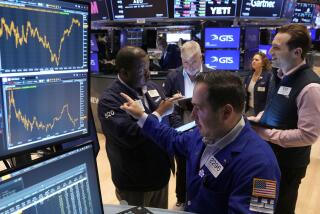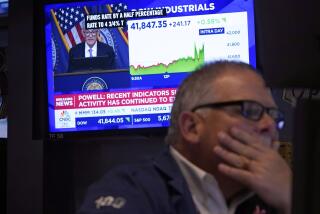Deal by Fed eases Europe credit fears
Reporting from Washington and Beijing — Europe’s worsening debt crisis has been a source of mounting fear and frustration for U.S. government officials and the biggest single threat to the struggling American economic recovery.
On Wednesday, policymakers found an opening to act, with the Federal Reserve coordinating a move by six central banks to give European lenders cheaper access to dollars.
The effort, designed to quell fears of a credit squeeze, triggered a huge rally in global stock markets, with the Dow gaining 490.05 points, the biggest one-day advance since March 2009. Markets also were bolstered by the Chinese central bank’s decision to ease monetary policy to support its economy, the world’s second largest.
No one expects the central banks’ move to end Europe’s crisis. But it was the most positive development in weeks, at least in the eyes of financial markets, in a crisis in which U.S. officials have labored, often without success and behind the scenes, to cajole their European counterparts to take more aggressive action.
President Obama has been making frequent calls to German Chancellor Angela Merkel. Treasury Secretary Timothy Geithner and Lael Brainard, his top deputy for the euro crisis, have been in daily contact with counterparts at the International Monetary Fund, the Fed and European institutions.
In the Treasury Department’s basement markets room, a dozen analysts have been monitoring computers, watching developments around the clock. Meanwhile, Brainard’s office has been functioning as a sort of war room, with a stream of economists offering updates at all hours.
The centerpiece of the Obama administration’s strategy has been to push the Europeans to create a big-enough bailout fund to limit the crisis to countries such as Greece and Italy. The officials want to make sure that the firewall is strong enough that the core Eurozone countries can borrow at affordable rates.
In terms of the size of the fund, the U.S. message, according to one official, has been “Whatever you’re thinking, add a zero.” But Europeans have repeatedly dialed back to significantly less than what the Americans say is needed.
“From the beginning, we have consistently urged the Europeans to build a credible firewall to prevent the crisis from spreading, strengthen European banks and confront the structural issues that are at the heart of the current crisis,” said Brainard, Treasury’s undersecretary for International Affairs.
The situation is all the more frustrating for the administration because it has had little success so far in imparting the lessons learned from the U.S. financial debacle.
“One of the most important lessons we learned from our own financial crisis is that you have to act with force and act quickly in order to get out ahead of markets,” Brainard said.
Fed Chairman Ben S. Bernanke also has expressed frustration that Europe hasn’t acted more forcefully. His action Wednesday, with the European Central Bank, Bank of Japan and three others, was seen as a collective resolve to avert the credit markets freeze that occurred after the collapse of Lehman Bros. in 2008.
But Bernanke’s options, like Obama’s, are limited by economics and politics.
The Fed could buy bonds of troubled European countries — an idea that some Washington policy analysts have advocated. But that would probably trigger a backlash from a Congress wondering why Americans should put skin in the game when the Europeans themselves, notably the Germans, are reluctant to backstop Italy, Spain and other troubled neighbors.
Obama could push for direct support of Europe’s crisis by asking for more money to be injected into the IMF for bailout purposes. But with the U.S. struggling with its own fiscal problems and deficit hawks controlling much of the debate in Congress, the president has insisted that Europe has the resources to handle its debt crisis.
The Fed’s action, while welcomed by the financial community, left analysts wondering why the markets reacted so euphorically.
It doesn’t cure the huge debt loads plaguing the Eurozone. That’s a problem senior U.S. officials readily concede they have little control over, even though the economy’s close links with Europe could mean, in the view of some analysts, that the U.S. is occupying the royal suite on Titanic.
The concern among administration officials reflects fears that a further meltdown in Europe could lead to a breakup of the 17-nation Eurozone and derail the weak U.S. recovery.
The U.S. sent more than $400 billion of exports to the 27-country European Union last year, and U.S. firms have over $1 trillion in direct investments in the EU, according to Douglas Elliott, a fellow at the Brookings Institution. What’s more, he said, U.S. banks and their subsidiaries have $2.7 trillion in loans and other commitments to the Eurozone.
Earlier this week, the Organization for Economic Cooperation and Development said that the euro area appears to be in a “mild recession” and lowered its forecast for U.S. economic growth next year to 2.1%, from 3% in May.
So far, the economic damage to the U.S. from Europe’s debt problems has come in the form of jolts to stock markets that have shaken confidence, adding to the uncertainty restraining business investment and hiring.
But if Europe were to get worse, analysts fear U.S. manufacturing, a star in this recovery, would be hurt. And the problem wouldn’t be just the result of slow sales to Europe, but would also involve the indirect effect of China.
Europe is China’s biggest export market. And if Chinese shipments to Europe were to tank, many American businesses that have significant investments in China would also be hurt, said Cliff Waldman, economist at Manufacturers Alliance/MAPI, a manufacturing research group.
On Wednesday, China’s central bank said it would cut the amount of money banks must hold in reserve, a move aimed at boosting the flow of cash in the country’s slowing economy.
The unexpected policy shift came after a year of tightening to rein in inflation and growing debt levels in an economy that still grew 9.1% for the 12 months that ended Sept 30. The rate was 9.6% for the same period last year.
The People’s Bank of China said it would lower the so-called reserve ratio requirements of large commercial banks by 0.5 percentage point starting Monday, the first such move since December 2008.
“Today’s surprise reserve ratio cut marks the start of an across-board easing policy for China,” said Qu Hongbin, an economist for HSBC. “This, plus tax cuts and additional fiscal spending should help keep China on track for a soft landing.”
More to Read
Inside the business of entertainment
The Wide Shot brings you news, analysis and insights on everything from streaming wars to production — and what it all means for the future.
You may occasionally receive promotional content from the Los Angeles Times.











